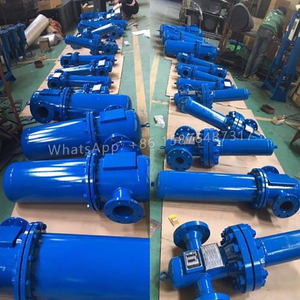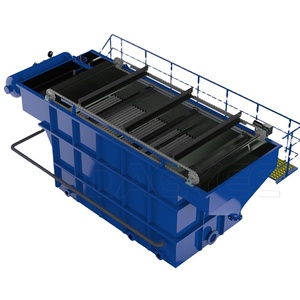
All categories
Featured selections
Trade Assurance
Buyer Central
Help Center
Get the app
Become a supplier

(578 products available)













A water vapor separator comes in various types designed for different functions and applications. Here are some common ones:
Hydrophobic filters
Hydrophobic filter cartridges are water vapor separators that prevent water from passing through while allowing air and vapor to pass. These filters are manufactured with specialized materials like polytetrafluoroethylene (PTFE), which has a high surface contact angle. The filters permit the passage of air and vapor through their pores but block the entry of water droplets due to surface tension, effectively trapping and repelling them. During the filter's operation, the hydrophobic filter allows compressed air, gas, or steam to move freely while blocking the passage of water. Hydrophobic filter cartridges are commonly used in diverse industries such as medical, pharmaceutical, petrochemical, food and beverage, and manufacturing.
Coalescing filters
Coalescing filters separate water from vapor by taking advantage of the different behaviors of water and vapor or air. Typically, these filters comprise a housing and a replaceable filter element. The filter elements are designed to allow the passage of oil or air and have a specific capacity to capture moisture. Once the moisture is captured, the filter forces it to coalesce and separate, effectively removing up to 99% of the water from the vapor. Coalescing filters find application in air compression and various industrial processes to remove liquid water from air or gas streams.
Cyclone separators
Cyclone separators use a centrifugal force to separate liquid water from the air by creating a vortex within the separator. They feature a cylindrical body that tapers inwards to a conical section at the bottom. When the vapor-laden airflow enters the separator, it is forced to circulate inside the cyclone separator, creating a vortex that separates the water due to the different densities. The water settles at the bottom cone of the cyclone separator, while the clean, dry air exits through the top.
Thermal moisture separators
Thermal moisture separators are designed to remove water condensate generated by thermal processes such as cooling or unintended condensation. Depending on the specific training process, these separators use different methods or mechanisms to separate the water from the condensate, typically including cooling, heating, or temperature change within a specific chamber. However, it's important to note that thermal moisture separators may not be used in every industry as the processes that lead to moisture generation happen in limited industries.
Dehydration of natural gas
Natural gas often contains a substantial amount of water vapor that must be removed before the gas can be transmitted through pipelines. Water vapor separators assist in the dehydration of natural gases, assuring effective transportation and minimizing the risk of hydrate formation.
Industrial compressed air systems
Compressed air systems are extensively utilized in industrial fields as a power source. Water vapor separators are commonly employed in compressed air systems to remove water vapor from the compressed air, preventing moisture contamination of the following pneumatic devices and guaranteeing compressed air quality.
Drying procedures
Numerous industrial sectors, including those manufacturing food, chemicals, textiles, and else, employ drying procedures. Water vapor separators may eliminate water vapor from the drying gas or air, enhancing drying efficiency and shortening drying times.
Medical and healthcare facilities
The healthcare industry must ensure that water does not contaminate critical gases like oxygen and anesthetic gases. This is to reduce the risk of pathogen development in medical pipeline systems. Medical gas water vapor separators can effectively remove water from these gases, improving the safety and efficacy of medical pipelines.
Laboratories and research institutions
Water vapor separators are frequently used in laboratories and research institutions. For example, in analytical instruments such as mass spectrometers, water vapor must be removed to reduce interference and ensure measurement accuracy. In addition, water vapor removers can also protect expensive laboratory equipment from the corrosive effects of water.
Hydrocarbon recovery in petrochemical industry
In the petrochemical sector, it is necessary to eliminate water vapor in order to recover hydrocarbon components from gas streams. Separators for water vapor may help enhance hydrocarbon recovery efficiency, lower production costs, and reduce the environmental impact by removing water vapor.
Power generation industry
Water vapor separators are key components in the power generation industry, such as in gas turbines or steam turbines. They remove water vapor from the fuel gas or working medium, ensuring the stable operation of the equipment and its safety.
While the functioning of a water vapor separator is of prime importance to avoid any gas/liquid carryover at the outlet, several other parameters need to be considered before purchasing one of these essential components.
Separator Type
Understand the working of various types of separators before deciding which one is suitable for use. Where chemical operations allow, coalescing plate separators are frequently used because they are efficient and cost-effective. However, if working with high pressures or where high separation efficiency is required, high-efficiency coalescing separators or hydrophobic membrane separators should be considered despite their higher costs.
Separator Sizing
Proper sizing of the separator is crucial for effective gas-water separation. A separator that is too small will not provide adequate space for the gas to rise and the droplets to settle, while one that is oversized will cause pressure drops and be a waste of resources. Typical approaches to sizing include calculating the operating pressure, flow rate, and droplet settling velocity, and using these parameters to model the separator's performance.
Separator Materials
Choosing the right material for the water separator is vital for the component's overall effectiveness. The separator material should be resistant to corrosion and chemical degradation, able to withstand high temperatures and pressures, possess mechanical strength to prevent deformation, and compatible with the fluid it processes.
Installation and Maintenance
Installation instructions should be available, and the user manual and maintenance schedule should be easily accessible. Regular maintenance is key to the longevity of gas water separators. Care should be taken to select a separator that needs minimal maintenance and to stay on top of maintenance practices to avoid any untimely gas-water separator failures.
Q1: What is the difference between a condensate separator and a steam filter?
A1: Although they serve distinct purposes, condensate separators and steam filters may possess certain common attributes. Primarily, the two apparatuses are created to handle distinct substances. While aboard, the condensate separator's primary objective is to eliminate water vapor from steam, ensuring the recovery of dry steam for energy efficiency and optimal system performance. On the other hand, the steam filter is designed to capture and remove impurities from the steam, including dirt particles, rust, and debris, to prevent the clogging of valves and quality deterioration of processes and equipment.
Q2: Why is it important to separate condensate from steam?
A2: Properly separating condensate from steam is crucial for preventing energy loss, reducing the risk of equipment damage, and maintaining product quality within industrial processes.
Q3: What is the principle of a steam separator?
A3: The steam separator works based on the principles of inertia, gravity, and buoyancy to differentiate between steam and other substances. The steam enters the separator, where it experiences a sudden change in velocity, allowing the water droplets to settle down and be directed to the outlet.
Q4: What types of steam separators are there?
A4: There are typically two kinds of steam water separators: mechanical and electrostatic. Mechanical steam separators include cyclonic and centrifugal eliminators. They utilize the inertial force created by high-velocity steam to separate water droplets. On the other hand, electrostatic steam separators employ electrostatic forces to separate charged water droplets from the steam.